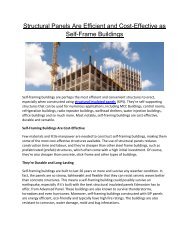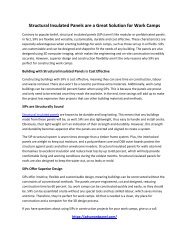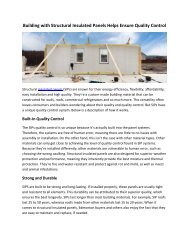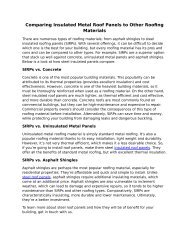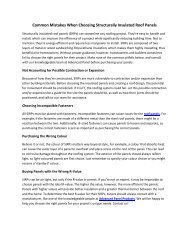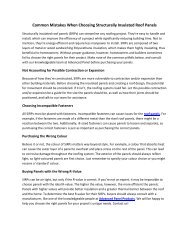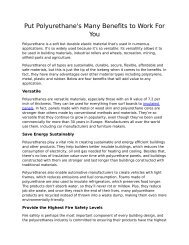Some Key FAQs for Structural Insulated Panels
Check out this post to find answers to some common questions about SIPs and their many benefits.
Check out this post to find answers to some common questions about SIPs and their many benefits.
- TAGS
- roof-panels
Create successful ePaper yourself
Turn your PDF publications into a flip-book with our unique Google optimized e-Paper software.
SIPs have a high fire rating, but they’re not completely fire-resistant, especially when applied to<br />
wood frame buildings. However, the application of a fire-resistant thermal barrier can make<br />
them more fire-resistant than any other building material. Fire-resistant barriers are typically<br />
gypsum board applied to the interior of SIP structures, including walls, roofs and temporary<br />
commercial structures.<br />
Do SIPs Improve Indoor Air Quality (IAQ)?<br />
Since steel insulated panels <strong>for</strong>m airtight seals, they prevent air from entering and exiting a<br />
building. This makes it easier to create a controlled indoor environment. A controlled<br />
environment allows you to manage the humidity and amount of air entering and leaving your<br />
home. This can create the highest IAQ and healthiest indoor environment. SIPs also limit air<br />
exchange to ventilation systems, filtering and dehumidifying incoming air. The process<br />
eliminates dust mites, mold spores and other allergens, which can improve IAQ even more.<br />
Do SIPs Work with other Types of Building Systems?<br />
Most builders use SIPs with different building systems because they’re very compatible. For<br />
example, SIP wall or roof panels can be applied to wood, insulated or poured concrete<br />
foundations. SIPs are also sized to fit seamlessly to dimensional lumber and stick framing. High<br />
energy-efficiency properties also make them perfect <strong>for</strong> insulating timber-framed buildings.<br />
More questions about SIPs? Give us a call to discover how SIPs can be of benefit to your project.





